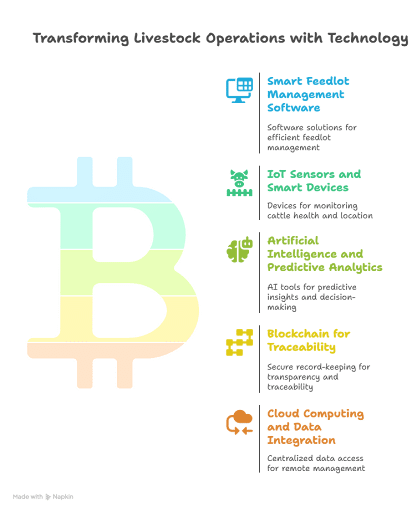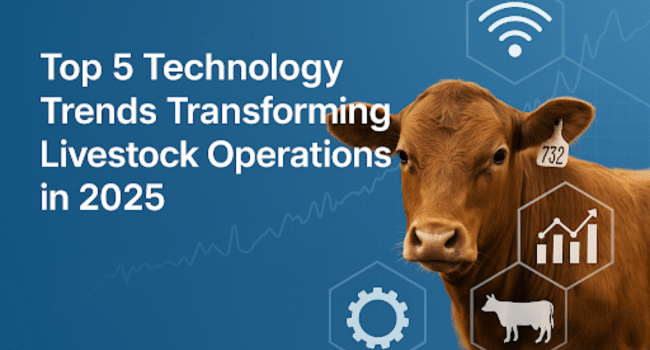Table of Contents
The livestock industry has entered a new era of digital transformation. As global demand for beef, dairy, and other animal products grows, livestock producers face mounting pressure to operate more efficiently, sustainably, and profitably. From fluctuating feed costs and labor shortages to strict traceability requirements, the challenges are significant.
Fortunately, technology is stepping up. In 2025, livestock operations are rapidly adopting digital-first tools like feedlot management software, IoT devices, AI, and cloud-based platforms to improve decision-making, reduce waste, and boost animal health.
In this blog, we explore the top five technology trends transforming how modern ranchers, farmers, and feedlot operators run their businesses.
1. Smart Feedlot Management Software
One of the biggest game-changers in livestock operations is the adoption of feedlot management software. Traditionally, feedlots relied on manual spreadsheets, handwritten records, and siloed systems. This created inefficiencies and left room for errors in areas like feeding schedules, weight tracking, and inventory control.
In 2025, digital platforms are reshaping how feedlots operate. Cattle feedlot software integrates every part of the operation—feeding, health management, inventory, performance tracking, and billing—into one centralized system.
Benefits of Feedlot Software:
- Precision Feeding: Optimize rations to reduce waste and maximize weight gain.
- Health Monitoring: Track vaccinations, treatments, and medical records in real time.
- Traceability: Comply with regulatory standards by tracking cattle from entry to sale.
- Profitability Insights: Access detailed reports on costs per head, feed conversions, and overall margins.
By adopting modern feedlot management software, producers gain complete visibility into operations and can make smarter, data-driven decisions.
If you’re managing a feedlot, investing in feedlot management software is no longer optional—it’s essential to staying competitive.
2. IoT Sensors and Smart Devices for Cattle Health
The Internet of Things (IoT) has already transformed industries like manufacturing and logistics, and now it’s redefining livestock operations. In 2025, more producers are equipping their cattle with wearable IoT devices and sensors that continuously collect data.
How IoT is Used in Feedlots:
- Wearable Collars and Ear Tags: Track animal activity, rumination, and behavior to detect early signs of illness.
- Temperature Sensors: Monitor cattle body temperature and detect fevers before symptoms appear.
- GPS Tracking: Improve grazing patterns and prevent cattle from straying too far.
- Automated Feeders: Adjust feed delivery based on cattle consumption and weight.
These connected devices feed real-time data into cattle feedlot software, allowing managers to respond quickly to health issues and optimize feeding. Early disease detection alone can save thousands of dollars by preventing the spread of illness across herds.
3. Artificial Intelligence (AI) and Predictive Analytics
Artificial Intelligence is no longer futuristic—it’s already in the field. Livestock operations in 2025 are using AI-powered predictive analytics to improve decision-making across every stage of production.
Applications of AI in Feedlot Operations:
- Predicting Weight Gain: AI models analyze feed intake, genetics, and health data to forecast growth rates.
- Disease Outbreak Prevention: Predictive analytics identify patterns that could signal upcoming health risks.
- Automated Image Recognition: Cameras use computer vision to monitor cattle body condition and detect anomalies.
- Smart Resource Allocation: AI optimizes labor, feed, and water usage to reduce costs.
When integrated with feedlot software, AI-driven insights enable feedlot operators to fine-tune their strategies and maximize return on investment. Instead of reacting to problems, producers can now prevent them.
4. Blockchain for Traceability and Transparency
Consumers and regulators are demanding greater transparency in the food supply chain. This is especially true in beef and livestock, where buyers want assurance that animals are healthy, ethically raised, and disease-free.
In 2025, blockchain technology is becoming a key driver of traceability. By creating an immutable digital ledger, blockchain ensures every transaction and activity in the cattle lifecycle is recorded and verified.
Benefits of Blockchain in Livestock Operations:
- End-to-End Traceability: Track cattle from birth through feedlot, processing, and retail.
- Enhanced Food Safety: Quickly trace contaminated products back to the source.
- Trust and Transparency: Provide retailers and consumers with proof of origin and quality.
- Regulatory Compliance: Simplify audits and meet stringent reporting standards.
By combining blockchain with cattle feedlot software, producers can create a secure, transparent system that benefits all stakeholders—from ranchers to retailers to consumers.
5. Cloud Computing and Data Integration
The backbone of all these innovations is cloud computing. In 2025, livestock producers are moving away from isolated, on-premises systems to cloud-based platforms that integrate data across the entire supply chain.
Why Cloud Technology Matters:
- Centralized Access: View all operational data—feed, health, inventory, sales—in one dashboard.
- Remote Management: Access feedlot data from anywhere, whether in the office or on the ranch.
- Scalability: Easily expand system capacity as operations grow.
- Collaboration: Share data securely with vets, nutritionists, and suppliers.
Cloud-enabled feedlot software not only improves efficiency but also ensures that valuable insights are never lost. With real-time data available on demand, producers can adapt quickly to changing conditions and market demands.

The Future of Livestock Operations
The livestock industry is at a turning point. Feedlots that rely on outdated systems and manual processes risk falling behind, while those embracing digital transformation are achieving higher profitability, healthier herds, and greater sustainability.
Key Takeaways:
- Feedlot management software centralizes operations and provides actionable insights.
- IoT devices enable real-time cattle health monitoring.
- AI and predictive analytics transform decision-making from reactive to proactive.
- Blockchain ensures trust, transparency, and regulatory compliance.
- Cloud computing creates a unified digital ecosystem for livestock operations.
As these technologies evolve, the livestock industry will continue to push boundaries, making operations smarter, more sustainable, and more profitable.
